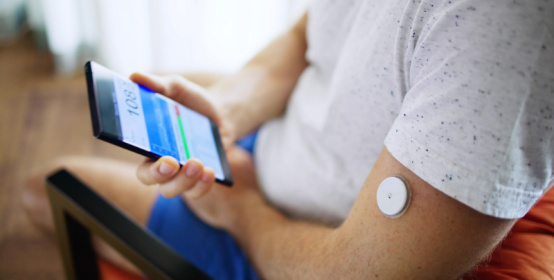
Diabetes isn't the easiest condition to manage. When your body needs help maintaining stable blood sugar, keeping tabs on your levels is absolutely crucial. In the past, finger sticks were the only way to do that. Unfortunately, they're painful and easy to forget to do, and the test strips can impact the accuracy of the results. New diabetes monitoring technology offers an easy, accurate alternative, but how does it work, and how well does it work?
Some diabetes monitoring tech still relies on tried-and-true finger sticks, but with a twist. New digital monitors offer users a wider window to submit a sample. That means that if the initial finger stick didn't produce enough of a blood sample, they can apply additional drops of blood to the testing area within a 60 second window and still get an accurate result. It saves users from either wasting test strips, or dealing with potentially inaccurate results.
Other new monitoring tech relies on implantable sensors. This is generally used for continuous glucose monitoring, which allows users to keep tabs on their glucose levels 24 hours a day. A device places the sensor just under the skin, and an adhesive patch holds it there. The sensor detects levels of glucose in the fluid just under the skin, and wirelessly transmits this data to a special receiver that lets the user view their results. Some models even have a cell phone app that displays the results instead.
These sensors need to be calibrated and changed regularly. Many models are good for a week or two, but there are some long-term sensors that can remain in place for up to six months.
Like any new tech, there are pros and cons to modern diabetes monitors. For example, older tech requires multiple finger sticks a day, where continuous monitors don't. Continuous monitors also allow you to download a log of your glucose readings, or even transmit this data directly to your doctor. New diabetes monitoring tech empowers users to see exactly how specific foods or physical activities impact their blood sugar and helps their care teams figure out how best to manage their diabetes.
On the other hand, using an under-the-skin sensor means learning how to correctly implant it. Some of these sensors also require calibration to ensure accuracy, so you might still have to do the occasional finger stick. While these devices are designed to be as user-friendly and low-maintenance as possible, they are pretty high-tech. That means learning how to operate their receivers (or accompanying cellphone apps), and upload and download data.
For people who use insulin pumps, glucose monitors come with an added bonus: They can send glucose readings directly to the pump. This helps better regulate blood sugar highs and lows.
In general, modern monitoring tech gives patients a better understanding of the ins and outs of their condition. While they might require more initial education and setup, they require fewer finger sticks, provide more information at a moment's notice, and may help improve compliance with diabetes treatment.
When the Centers for Medicare and Medicaid Services opted to expand coverage for continuous glucose monitors, it was seen as a big win for diabetes monitoring tech. Across the board, the companies that make glucose monitors and insulin pumps have been working to improve and expand their offerings.
Senseonics, makers of the Eversense E3, are looking to increase their sensors' working life from 180 days to a full year. This means that the implantable sensor would only need to be put in once a year. As long as its regularly calibrated and functioning, it'd keep monitoring all year long before needing to be replaced.
Dexcom, another continuous glucose monitor manufacturer, is looking to expand their products beyond type 1 and 2 diabetes. They're hoping to provide continuous glucose monitoring during pregnancy, in a hospital setting, and more. The company also wants to improve their sensors, by increasing their lifespan from 10 days to 15.
Beta Bionics, meanwhile, is still working on launching a bionic pancreas system. This system, called iLet, would interface with a continuous glucose monitor to provide insulin. Using the user's body weight, glucose readings, and a very general estimate of the carbohydrate count in meals, the iLet would provide a customized basal insulin rate, as well as automatically make corrections to keep blood sugar within a healthy range.
New diabetes monitoring tech isn't just less painful and more convenient, it can also save lives. It offers more information to doctors and patients alike, and can interface with diabetes treatment methods to better smooth out blood sugar highs and lows. As diabetes monitoring and treatment technology continues to improve, so will patients' outcomes.